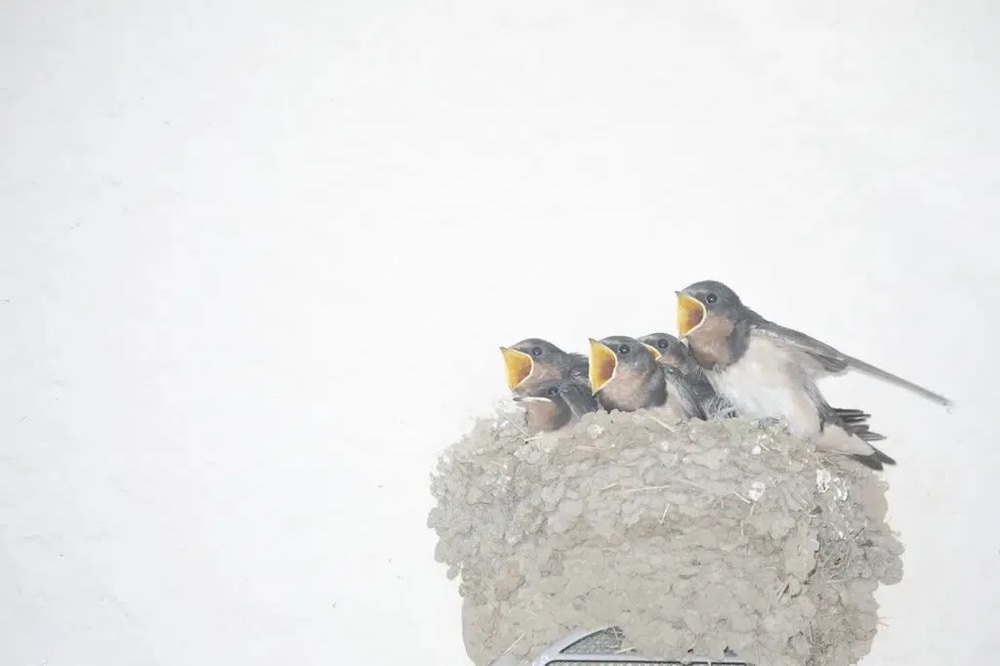Birds in the trees: all is right in the world unless it’s three in the morning and their birdsong is interrupting your sleep. Birds on a telephone wire: a testament to adaptation in one’s habitat; I hope it doesn’t ruin your connectivity. Birds on the beach: better protect your picnic lunch. Birds in a graveyard: run like hell.
“Del Cielo (Of the Sky),” the current ornithological display at Rose Gallery, is a charming photographic diversion—a mix of the naturalistic, filmic, kitsch, allegorical, and literal—albeit with occasional flashes of melancholy. It’s “birds five ways,” so to speak, with each artist from this archival show presenting a different spin on the meaning of birds—their associations, their aesthetics, their implications, and the affective reaction they provoke.
Rinko Kawauchi’s “Des Oiseaux (On Birds)” series goes straight for the “cute” factor. A grouping of small photographs, “Des Oiseaux (On Birds)” depicts a family of swallows in a nest, and several of the images focus on the baby birds with their expectant and hungry open mouths as they wait for feeding time. The swallows are interspersed on the gallery wall at unexpected hanging heights, accented by images of the sky, the sun, and the tips of trees seen from below, setting the scene for an ultimately very charming array of images.
Where the baby swallows of the “Des Oiseaux (On Birds)” series trigger an instinct to “ooh” and “aw,” the same birds—swallows—framed differently in Graciela Iturbide’s Cementerio (part of her “Pájaros” series) precipitate a horror or seem to escape its aftermath. In this work, a woman carrying branches appears to exist on the same flat plane as the blurred outlines of frenzied swallows, and the effect is stunning. The “Pájaros” body of work, taken in the aftermath of an infant’s funeral, is dazzling and cinematic as if Iturbide has somehow captured the most thematically resonant and technically audacious possible moment in time.

From Rinko Kawauchi’s series “Des Oiseaux (On Birds).
Meanwhile, the poetical form of the raven takes on an appropriately despairing air in Masahisa Fukasa’s series “The Solitude of Ravens,” where these birds, depicted against dark-tinted skies, reflect the artist’s emotional state following his divorce. The images are dim and oppressive, devoid of hope. Ravens and other birds appear as posed “effigies” in Jo Ann Callis’ section of “Del Cielo” presented in a mix of humorous and foreboding interior settings. In James Gallagher’s “Bird Portraits”—the fifth group of works in Del Cielo—images of birds superimposed atop anonymously proper sepia-toned people serve as collaged riffs on the conventions of portraiture.
Birds are certainly intriguing as icons, and they are ubiquitous in art and in popular culture. Many of the individual works in “Del Cielo” provoke strong reactions—delight, humor, even pathos. Placing these expressions of the theme in conversation, however, proves more intriguing. It’s possible to tease out specific parallels and contrasts in the works chosen, particularly with the show’s opening text. For example, the familial sundering referenced with such sorrow by Fukasa is a gloomy rejoinder to Kawauchi’s images of swallows feeding their young—a bird species that, incidentally, mates for life. Additionally, the surreal otherworldliness of Iturbide’s works, and their allusions to death as described in the show’s opening text, are interestingly juxtaposed with Callis’ own play on life and death: her bird “effigies” that still seem to be so dramatically alive. Callis’ work Salt, Pepper, Fire, where a flame both obscures and melts into the form of a bird darting out of the composition, is a particularly striking example. Rose Gallery could have leaned even further into playing with these thematic connections in “Del Ciel











0 Comments